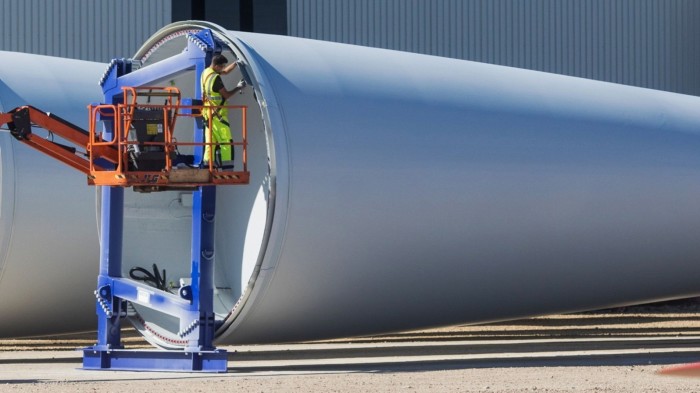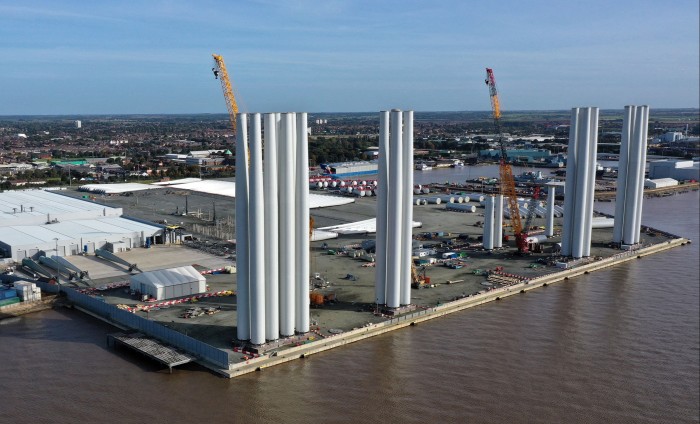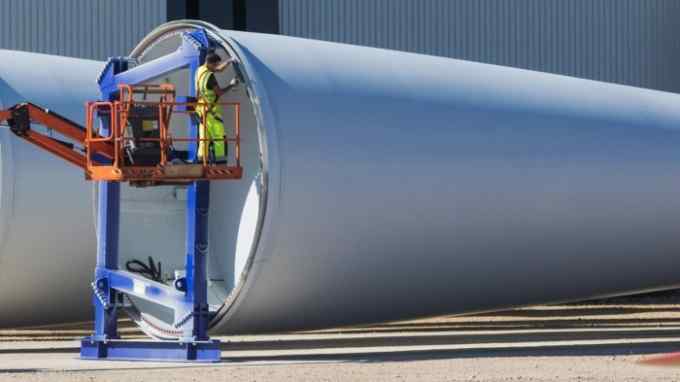Green subsidies lift wind industry’s longer term prospects

Roula Khalaf, Editor of the FT, selects her favourite stories in this weekly newsletter.
Wind turbine makers expect their fortunes to remain challenging this year, but are hoping for a turnround in 2024 as US legislation fuels investment there and European policymakers speed up the years-long permitting process.
Manufacturers including Vestas and Siemens Gamesa warned in January that the wind industry would continue to suffer in 2023, due to high materials costs and slow approvals for new wind power projects in Europe. Siemens Gamesa’s chair, Christian Bruch, said the industry was “facing serious financial challenges”.
Executives and analysts remain hopeful about the longer term outlook, though. They point to the US Inflation Reduction Act (IRA), which has earmarked $369bn for clean energy and climate-related projects — and has pushed European policymakers to step up their support for green industries.
“I think there is some good news on the horizon,” including the falling prices of raw materials including steel, says Elena Pravettoni, clean power lead at the Energy Transitions Commission think-tank.
These last 12 months, however, have been a rocky time for the windpower industry, despite a growing demand for renewable sources amid the European energy crisis, Inflation and supply chain delays have squeezed margins and contributed to job cuts. At the same time, the slow approvals process in Europe has held back growth in the sector, which faces aggressive competition from China.
But, now, the passing of the IRA has injected new excitement into the US and EU renewables industry. “We think this is really a turnround year,” says Ben Backwell, chief executive of the Global Wind Energy Council. In Europe, he says, orders for wind turbines are expected to increase. In the US, the IRA will give onshore wind “a massive boost”.
Although the US and Europe are both growth markets, leading turbine makers’ requirements differ in the two regions. In Europe, they are pushing for faster planning and permitting processes for new projects. The think-tank Ember has found that obtaining permits for new onshore schemes could take up to 10 years. EU legislation says it should take no more than two.

Alessandro Boschi, head of the European Investment Bank (EIB) renewable energy division, says the slow permitting process is “one of the main reasons for investments not picking up at the pace needed”.
Back in 2019, Fachagentur Windenergie an Land, a Berlin-based industry association, found that about a fifth of permitted projects in Germany faced legal challenges — including from environmental groups and individuals on wildlife protection grounds. This level of opposition remains about the same today, it notes.
Industry body WindEurope welcomes EU moves to accelerate the renewables rollout but notes many proposals have yet to be implemented. “We will probably only see the effects of this on average permitting times in some months from now,” WindEurope says.
In the US, turbine manufacturers also need clarity on how they will be able to take advantage of IRA incentives. Siemens Gamesa noted in January that uncertainty over the rules and eligibility was “limiting the ability for industry players to make significant investment decisions in the near term”.
Vestas’s group senior vice-president of marketing and public affairs, Morten Dyrholm, says the IRA is “a good example of what we think policymakers should be focusing on” — but adds that the company is awaiting official guidance from the US tax authorities on how they can use the act.
Vestas, which has a presence in the US, is “not making any premature investment decisions”.
Even so, Dyrholm expects the IRA to drive a significant rise in renewables investment. The “risk” for Europe is that future investments move to other growth markets, including the US and Asia, he says.
For many European companies, the biggest issue is how to compete with Chinese turbine manufacturers. The EIB has stressed the importance of competing on technology and quality grounds, rather than on price, and the industry has called for policymakers to develop a domestic supply chain for the raw materials needed for turbines, to reduce reliance on China.
“As China and now the US pursue strong industrial policies to promote clean energy manufacturing, the EU needs policies to maintain and expand its manufacturing base,” says Lauri Myllyvirta, lead analyst at the Centre for Research on Energy and Clean Air.
Backwell says most countries have under invested in the wind supply chain, apart from China. “You can see certain markets becoming very tight in the coming years,” he predicts, given the fact that supply chains will struggle to keep up with rising demand. More investment and co-ordination between industry and governments will be needed to meet increasing demand, he believes.
While some of Europe’s green industries have sounded the alarm over the IRA, fearing it could lure domestic supply chains to the US, analysts expect the act to benefit leading European turbine makers that operate in both markets.
The US legislation should support demand for wind turbines, according to analysts at Fitch Ratings, but they do not expect European manufacturers and suppliers to see its benefits before 2024.
While “profitability is under pressure” for European manufacturers, they say, “long-term demand for renewable energy equipment remains strong”.
In the UK, policymakers must step up efforts to ensure the market remains competitive, warns Claire Mack, chief executive of industry group Scottish Renewables. But anything driving an increase of operations “is a good thing” for economies of scale and innovation in the industry, she adds.

Comments